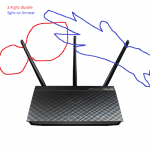Alienbliep
Occasional Visitor
Goodday,
I have two routers
The rt-n18u and rt-n66u
The rt-n18u is 2.4ghz only
Rt-n66u 2.4 and 5ghz
Both have different antenna so i opened both antennas.
Inside they are different to. Is this because of dbi? Or 2.4 vs 5ghz?
The lower is rt-n18u 2.4ghz, upper is rt-n66u
I know the rt-n18u has 5dbi antennas
Are the rt-n66u antennas 5dbi too?
I have two routers
The rt-n18u and rt-n66u
The rt-n18u is 2.4ghz only
Rt-n66u 2.4 and 5ghz
Both have different antenna so i opened both antennas.
Inside they are different to. Is this because of dbi? Or 2.4 vs 5ghz?
The lower is rt-n18u 2.4ghz, upper is rt-n66u
I know the rt-n18u has 5dbi antennas
Are the rt-n66u antennas 5dbi too?
Attachments
Last edited:





